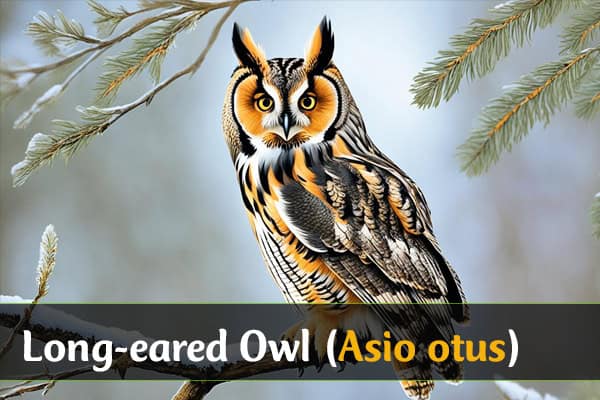Long-eared Owl (Asio otus) With Photos
Ever wondered what makes the long-eared owl stand out? Its unique ear tufts, long body, and surprised look make it special. But there’s more to this owl than meets the eye. Let’s explore the amazing skills that make it a top hunter in the night.
The Majestic Long-eared Owl
The long-eared owl, known as Asio otus, is a fascinating bird found in North America, Europe, and Asia. They are easily spotted by their long ear tufts that stand straight up. This gives them a curious look.
Basic Description and Identification
Long-eared owls are medium-sized birds with a wingspan of up to 96 cm (38 inches). Their feathers are mottled in buff and brown, with darker streaks. This helps them blend into their surroundings. They are quiet hunters, often hidden in dense trees.
Range and Habitat
These owls live in many places, including North America, Europe, and parts of Asia. They like semi-open areas, such as woodland edges and margins. Here, they can roost and nest in dense foliage while hunting over open ground. They adapt well to different wooded places, from small shelter belts to large forest edges.
The long-eared owl’s unique look and secretive ways have always caught the eye of birdwatchers and nature lovers. Their special traits and varied habitats make them a fascinating species to learn about.
The Long-eared Owl’s Hunting Prowess
The long-eared owl is a master of silent flight and precise hunting. Its flight feathers have special edges and downy surfaces. These features help it sneak up on its prey without making a sound. The owl also has unique ear openings and large facial disks. These help it hear very well, even in total darkness.
Diet and Prey
The main part of the long-eared owl’s diet is small rodents, like voles. But, it can also eat birds and insects if it needs to. This flexibility helps it survive in different environments.
| Prey Type | Percentage of Diet |
|---|---|
| Voles | 60-80% |
| Other Small Rodents | 10-30% |
| Birds | 5-10% |
| Insects | 1-5% |
Thanks to its amazing hunting skills, the long-eared owl can live in many places. It can adjust to changes in what’s available to eat. This keeps it a key part of its ecosystems.
Nesting and Breeding Behavior
The long-eared owl (Asio otus) has unique nesting and breeding habits. Unlike many owls, they don’t build their own nests. Instead, they use nests made by other birds, like crows and magpies.
This behavior is key to the long-eared owl. Their success in breeding depends on finding enough food and avoiding predators. They focus on areas rich in small mammals like voles, mice, and shrews.
Nesting Habits
Long-eared owls nest in various places, such as woodlands with trees like willows and junipers. They often take over nests built by other birds. These nests are about 2.5 inches deep and 8.5 inches wide.
During breeding, they may nest close together, just 50 feet apart. They form monogamous pairs, staying together through the breeding season.
| Nesting Behavior | Details |
|---|---|
| Nest Type | Stick nests abandoned by other bird species |
| Nest Dimensions | Nest cup: ~2.5 inches deep, ~8.5 inches in diameter |
| Clutch Size | 2-10 eggs |
| Egg Dimensions | 1.5-1.7 inches in length, 1.2-1.4 inches in width |
| Incubation Period | 25-30 days |
| Fledging Period | Approximately 30 days after hatching |
The long-eared owl’s nesting and breeding habits are quite interesting. They show how adaptable and resourceful these owls are in their different habitats.
Long-eared Owl Subspecies
The long-eared owl is a fascinating bird found all over the world. It has many long-eared owl subspecies that have changed to live in different places. These include the A. o. otus in the Palearctic region, A. o. canariensis in the Canary Islands, A. o. wilsonianus in Canada and the US, and A. o. tufts from western Canada to south-central USA.
Variations Across Different Regions
These long-eared owl regional variations look a bit different from each other. They have changed in size, color, and eye color to fit their homes and climates. For example, the A. o. canariensis in the Canary Islands has darker feathers to hide in the volcanic lands. The A. o. tuftsi in western North America is bigger to survive in different lands and find food.
| Subspecies | Geographic Range | Key Characteristics |
|---|---|---|
| A. o. otus | Palearctic region | Nominate subspecies, found throughout Europe and Asia |
| A. o. canariensis | Canary Islands | Endemic to the Canary Islands, may have darker plumage |
| A. o. wilsonianus | Canada and the United States | Found in parts of North America, slightly larger than A. o. otus |
| A. o. tuftsi | Western Canada to the south-central USA | Ranges from western Canada to south-central United States, maybe slightly larger |
These different long-eared owls show how well they can adapt and the amazing diversity within a species. When birds are separated and face different environments, they can change a lot over time.
Read Our Previous Articles:
Intriguing Facts about the Long-eared Owl
The long-eared owl is a fascinating creature with unique traits and behaviors. It is known for its impressive shooting range and hunting skills. These owls have many captivating facts that show their remarkable nature.
Cool Facts and Trivia
Did you know a male long-eared owl’s hoot can be heard up to 1 kilometer (0.7 miles) away? This shows their amazing vocal skills. They can communicate over long distances.
Long-eared owls are known for flying silently and hunting with precision. Their special feathers and ear placement help them sneak up on prey. This makes them great hunters.
These owls also like to use nests built by other birds, like American crows and Cooper’s hawks. This saves them energy and helps them focus on their young.
The long-eared owl can live up to 12 years and 1 month. This shows how resilient and adaptable they are.
The long-eared owl is amazing with its vocal range, hunting skills, and nesting habits. It captures the interest of bird lovers and nature experts.
Wrapping Up…
The long-eared owl is a fascinating bird with amazing skills and behaviors. It is known for its silent flight and precise hunting. It also has unique ways of nesting and living in different places.
This bird has caught the eye of many, including birdwatchers, conservationists, and nature lovers. Despite some challenges in some areas, it is still one of the most common owls worldwide. This shows how resilient and adaptable it is.
This guide has shown us the long-eared owl’s many sides. It has a deep history and plays a key role in nature’s balance. Its looks, hunting skills, and the beauty of nature make it special.
We must keep working to protect the long-eared owl and its home. This will help it survive for many years. By learning about and caring for this owl, we can ensure it continues to fill our skies with beauty.
Ever wondered what makes the long-eared owl stand out? Its unique ear tufts, long body, and surprised look make it special. But there’s more to this owl than meets the eye. Let’s explore the amazing skills that make it a top hunter in the night.









